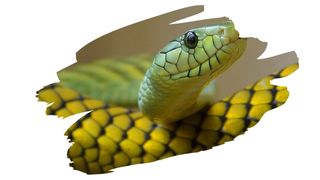Paint is probably one of the most whiff-potent wood finishes around, when it comes to releasing lung-burning fumes. And — as anyone who has painted a room can attest to — paint fumes can stink up the place for weeks.
And those fumes are a very real concern — especially if you want to add a coat of it to a reptile enclosure. Why? Well because if those paint fumes are enough to make you wheeze, imagine what they could do to the tiny lungs of your pet reptiles!
So, if you want to paint a wooden reptile enclosure, is there a fume-free paint you can use?
Well, in this post, we dive into what Volatile Organic Compounds (VOC’s) actually are — and why they matter. You’ll also discover which types of paint are completely VOC free.
And keep reading to find out if it’s worth risking using acrylic or enamel paints on a vivarium.

This post may contain affiliate links to products that we receive a commission for (at no additional cost to you). Learn more here.
Are Paint Fumes Harmful To Reptiles?
Short answer? Yes, they are.
Long answer? Well, the fumes in paint, (and other solvents), are what are often referred to as VOC’s (aka Volatile Organic Compounds). And those VOC’s are behind the cough-inducing smell that wafts off of paint as it dries.
But, if you’ve ever painted a room, you probably know that even dry paint can continue to release fumes. In fact, paint can release VOC’s for up to six months after it has been applied.
And if those VOC’s are enough to cause you to cough, you can only imagine what sort of harm they’re doing to your pet.
Is Acrylic Paint Safe For Reptiles? No, it is not. Acrylic paints are filled with chemical pigments and microplastics. And this type of paint releases fumes into the air as it dries.
Related Post: Is There A Food Safe Paint For Wood?
So What Kind Of Paint Is Non-Toxic To Reptiles?
The main thing you need to watch out for are VOC emissions.
Any paint you use needs to be VOC-free. And it should not release fumes during (or after) application.
Typically, 100% VOC free paints are made from natural ingredients. And these ingredients can include things like essential oils and tree resins.
But, these particular types of natural-ingredient paints can also attract mold bacteria. Which makes them unsuitable near high-humidity environments, (such as say a tropical reptile’s cage).
That’s why — if you want a durable VOC-free paint — you need to use one that still contains man-made chemicals in it. Nevertheless, those chemical ingredients should not produce harmful fumes or side effects.
So, one of the best VOC-free paints on the market comes from Little Knights.
Their odorless 100% VOC-free paint does not contain dangerous solvents. And this makes this paint safe to have around both your pets, and yourself.
What About Spray Paint? Is It At All Reptile Safe?
Not even close. Spray paints contain chemicals, such as zinc and lead.
And their airborne application means that they’re an even worse VOC-emitting culprit than other solvent paints.
OK. So Is There A Natural Ingredient Paint That’s Safe Around Reptiles?
If you don’t mind using a less-than-durable paint product, you could consider using Milk Paint.
Milk paint contains milk proteins, natural pigments, and calcium carbonate (lime). So, there are no toxic chemicals thrown into the mix.
What’s more, none of the ingredients in this particular paint will release fumes, so it is 100% VOC free.
It is surprisingly easy to apply too, since it does not need a primer coat before application. You can simply apply it directly onto raw wood.
What’s more, it takes fewer than 30 minutes to dry to the touch. Plus, it doesn’t wash off easily either.
But, best of all, this paint is both biodegradable and eco-friendly.
Related Post: Is There A Reptile Safe Wood Sealer? Here’s What You Should Know
OK. But What Are The Disadvantages Of Using Milk Paint On Wood?
There are three main problems with using this paint;
1). It Is Not Very Durable
It’s true that milk paint does not wash off all that easily. However, if it becomes saturated by moisture and humidity, then it can still become water-damaged.
2). It Is A Thin Paint
It’s all-natural ingredients means that milk paint does not contain the bonding agents that solvent paints have.
So, this means that this fairly watery paint product will need more coats than usual. And it will take 4+ coats of milk paint to get a good coverage.
3). It Is Always A Matte Finish
High gloss paints have the gloss added to them using special chemical additives. Milk paint, on the other hand, does not contain any of those additives.
So, milk paint always leaves behind a matte finish. This can leave the surface of wood looking a touch waxy, rather than shiny.
What About Enamel Paint? Is Enamel Paint Safe To Use Around My Pet Reptiles?
Enamel paint is not reptile safe.
First off, oil-based enamel paints contain poisonous amounts of methyl alcohol, (which is also highly flammable). And even water-based enamel paints have toxic ingredients, such as white lead, in them.
But the biggest risk in using these paints still relates to their VOC-content. They are not VOC-free, so all of those fumes aren’t great to have lingering around your pet’s home.
To Wrap Up, Here Are The 3 Key Takeaways From This Post…
- 1). Solvent-based paints, such as Acrylic Paints and Enamel Paints, can release fumes for months after application.
- 2). Those paint fumes, (known as Volatile Organic Compounds), are dangerous if they drift around on the air near your pet.
- 3). Only use 100% VOC-free paint to coat a reptile enclosure.
References
Long-term Impact of Formaldehyde and VOC Emissions from Wood-based Products on Indoor Environments | Sagepub.com
Enamel (Paint) – an overview | ScienceDirect
White Lead | Wikipedia.org
